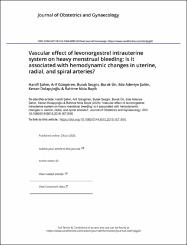Vascular effect of levonorgestrel intrauterine system on heavy menstrual bleeding: is it associated with hemodynamic changes in uterine, radial, and spiral arteries?

Göster/
Tarih
2019Yazar
Şahin, HanifiGüngören, Arif
Sezgin, Burak
Ün, Burak
Şahin, Eda Adeviye
Dolapcıoğlu, Kenan
Bayık, Rahime Nida
Üst veri
Tüm öğe kaydını gösterÖzet
The aim of this study was to evaluate the clinical and blood flow changes associated with the use of a levonorgestrel-releasing intrauterine device (LNG-IUD) in patients with idiopathic heavy menstrual bleeding (HMB). LNG-IUD was inserted into a total of 91 patients (39.5 +/- 5.4 years) who were diagnosed with HMB. Uterine volume, ovarian volume, uterine, radial and spiral artery blood flow, Pictorial Blood Loss Assessment Chart (PBAC) scores, and other clinical and laboratory parameters were evaluated before and 12 months after insertion of LNG-IUD. Compared to pre-insertion values, LNG-IUD dramatically improved haemoglobin, PBAC scores, and endometrial thickness. Mean resistance indices of radial and spiral arteries significantly increased 12 months after insertion. Our study results suggest that a significant increase in the resistance indices of the intra-myometrial arteries in LNG-IUD users one year after insertion may be due to its local progestational effects, indicating a possible mechanism of LNG-IUD in reducing menstrual blood flow.Impact Statements What is already known on this subject?The mechanisms of action of LNG-IUD on heavy menstrual bleeding include atrophy, decidualization and vascular changes of in the endometrium, resulting endometrial suppression. However, the exact mechanism to stop bleeding is not clear. What do the results of this study add?The present study suggests that one of the effects of the LNG-IUD on heavy menstrual bleeding is its ability to increase the resistance indexes of the intra-myometrial arteries. What are the implications of these findings for clinical practice and/or further research?These results will foster further studies on the effects of LNG-IUD on intra-myometrial arteries and will further assure clinicians on the vascular effect of LNG-IUD during management of heavy menstrual bleeding which includes hysterectomy as a final step.

















